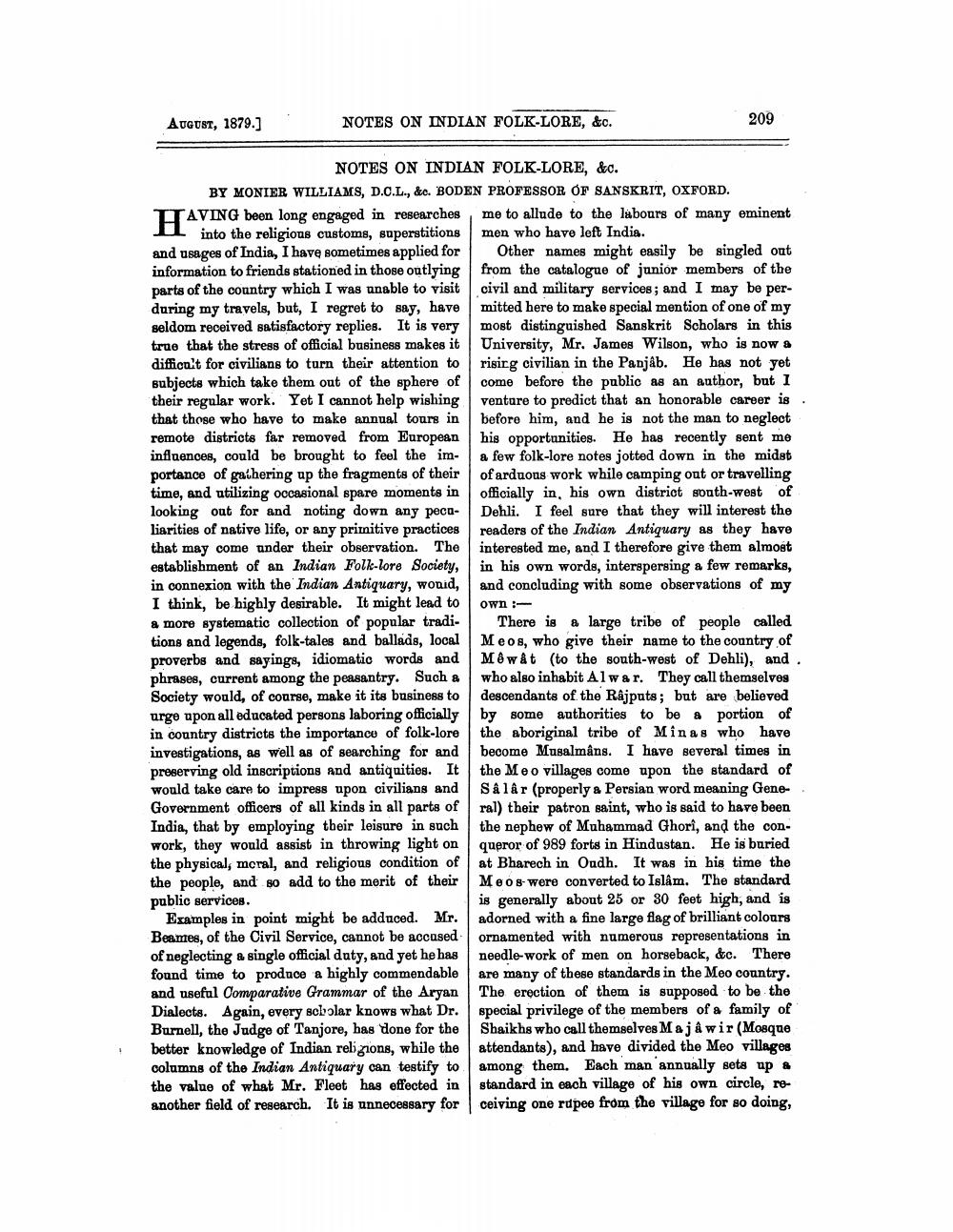________________
AUGUST, 1879.]
NOTES ON INDIAN FOLK-LORE, &c.
NOTES ON INDIAN FOLK-LORE, &c.
BY MONIER WILLIAMS, D.C.L., &c. BODEN PROFESSOR OF SANSKRIT, OXFORD.
HA
AVING been long engaged in researches into the religious customs, superstitions and usages of India, I have sometimes applied for information to friends stationed in those outlying parts of the country which I was unable to visit during my travels, but, I regret to say, have seldom received satisfactory replies. It is very true that the stress of official business makes it difficult for civilians to turn their attention to subjects which take them out of the sphere of their regular work. Yet I cannot help wishing that those who have to make annual tours in remote districts far removed from European influences, could be brought to feel the importance of gathering up the fragments of their time, and utilizing occasional spare moments in looking out for and noting down any peculiarities of native life, or any primitive practices that may come under their observation. The establishment of an Indian Folk-lore Society, in connexion with the Indian Antiquary, wonid, I think, be highly desirable. It might lead to a more systematic collection of popular traditions and legends, folk-tales and ballads, local proverbs and sayings, idiomatic words and phrases, current among the peasantry. Such a Society would, of course, make it its business to urge upon all educated persons laboring officially in country districts the importance of folk-lore investigations, as well as of searching for and preserving old inscriptions and antiquities. It would take care to impress upon civilians and Government officers of all kinds in all parts of India, that by employing their leisure in such work, they would assist in throwing light on the physical, moral, and religious condition of the people, and so add to the merit of their public services.
Examples in point might be adduced. Mr. Beames, of the Civil Service, cannot be accused of neglecting a single official duty, and yet he has found time to produce a highly commendable and useful Comparative Grammar of the Aryan Dialects. Again, every scholar knows what Dr. Burnell, the Judge of Tanjore, has done for the better knowledge of Indian religions, while the columns of the Indian Antiquary can testify to the value of what Mr. Fleet has effected in another field of research. It is unnecessary for
209
me to allude to the labours of many eminent men who have left India.
Other names might easily be singled out from the catalogue of junior members of the civil and military services; and I may be permitted here to make special mention of one of my most distinguished Sanskrit Scholars in this University, Mr. James Wilson, who is now a rising civilian in the Panjab. He has not yet come before the public as an author, but I venture to predict that an honorable career is. before him, and he is not the man to neglect his opportunities. He has recently sent me a few folk-lore notes jotted down in the midst of arduous work while camping out or travelling officially in, his own district south-west of Dehli. I feel sure that they will interest the readers of the Indian Antiquary as they have interested me, and I therefore give them almost in his own words, interspersing a few remarks, and concluding with some observations of my
own :
There is a large tribe of people called Meos, who give their name to the country of Mê wat (to the south-west of Dehli), and. who also inhabit Alwar. They call themselves descendants of the Rajputs; but are believed by some authorities to be a portion of the aboriginal tribe of Minas who have become Musalmâns. I have several times in the Meo villages come upon the standard of Sâlâr (properly a Persian word meaning General) their patron saint, who is said to have been the nephew of Muhammad Ghorî, and the conqueror of 989 forts in Hindustan. He is buried at Bharech in Oudh. It was in his time the Meos were converted to Islâm. The standard is generally about 25 or 30 feet high, and is adorned with a fine large flag of brilliant colours ornamented with numerous representations in needle-work of men on horseback, &c. There are many of these standards in the Meo country. The erection of them is supposed to be the special privilege of the members of a family of Shaikhs who call themselves Majâ wir (Mosque attendants), and have divided the Meo villages among them. Each man annually sets up a standard in each village of his own circle, receiving one rupee from the village for so doing,




